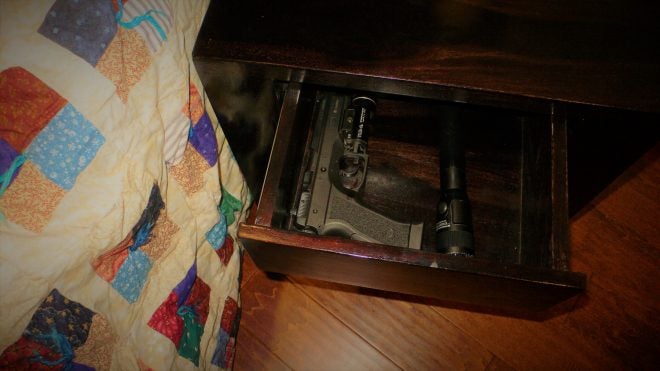Welcome to the first installment of First Firearm series. We’re starting off in a slightly predictable way with considerations for your first Home Defense (HD) handgun. However, for those that aren’t ready or able to jump into concealed carry, having the ability to protect one’s self in their castle is a reasonable place to start gun ownership. I couldn’t even count the number of bumps in the night my wife or I have woken up to and felt the need to investigate. I imagine others have had such rude awakenings at some point in their life. One doesn’t need to look too deep in a newspaper or watch much nightly news to understand that break-ins are a thing.
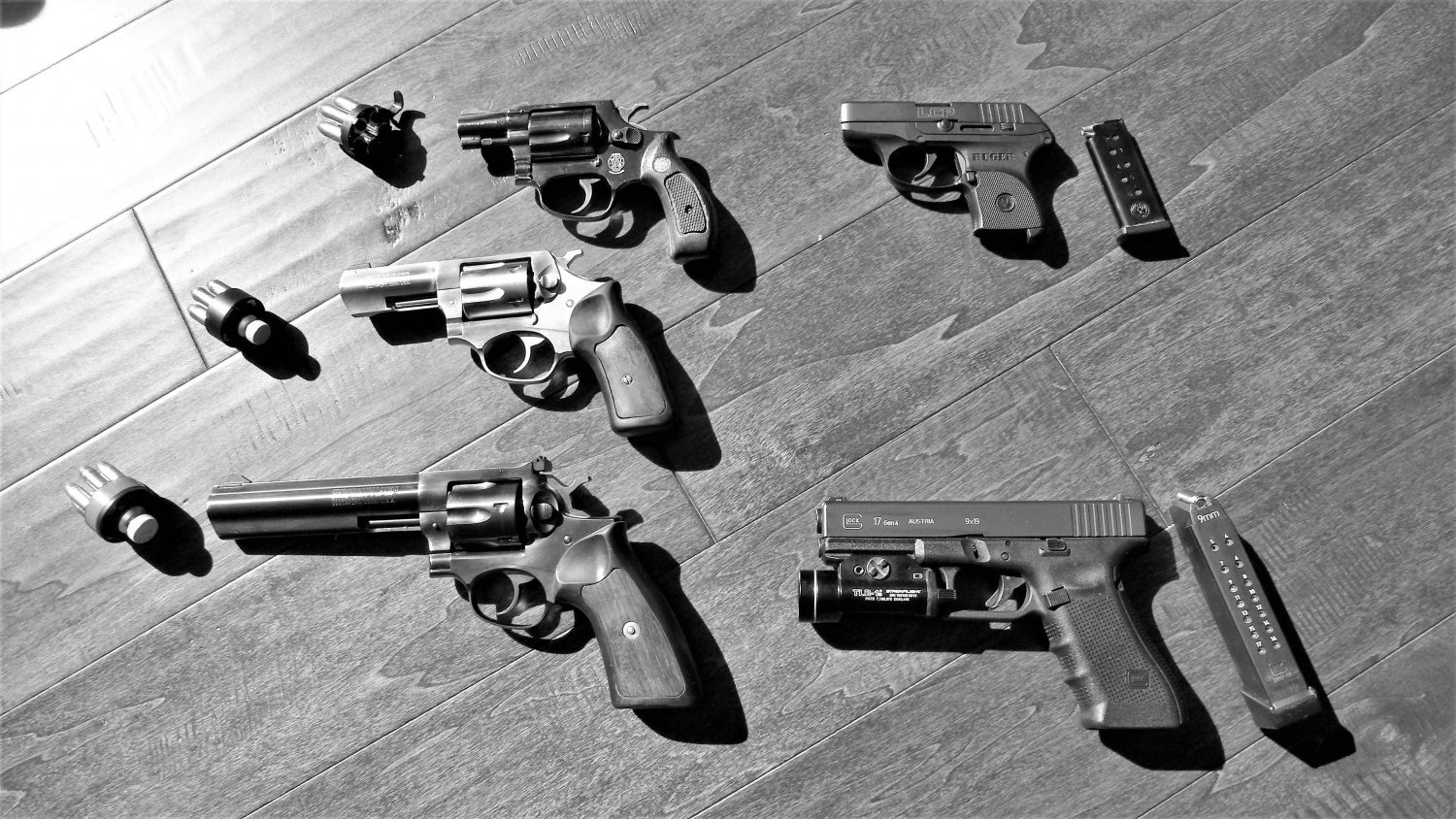
Various sizes of revolvers and semi-auto handguns.
SIZE
The size of your first handgun for HD gives you plenty of options. For some people, either for simplicity sake or budgetary constraints, you may want your first handgun to also pull concealed carry duty later on. If that’s the case you may want to narrow your search to mid-sized, subcompact size or pocket guns. Although, if you don’t plan to conceal your HD handgun on your person outside the home later on, your options aren’t as limited and you can consider a full sized handgun for HD.
There are several advantages to full sized pistols and revolvers. The larger grip size gives more space for a full handed grip which gives better control during recoil. Full-sized semi-auto pistols also have the potential for more ammunition capacity since the magazine is typically stored in the grip. In revolvers, a larger frame can facilitate a larger cylinder holding 7 or 8 rounds (depending on caliber) compared to the traditional 6 rounds or less. Full-size handguns also have more weight to soak up recoil which can help in controlling the gun. Having a longer barrel and more pronounced sights and sight radius can lead to better accuracy as well, compared to pocket guns. Unless money is pretty tight, I’m an advocate of being able to learn to shoot on full-sized or mid-sized handguns. I’ve found that small, concealable handguns are typically not that fun to shoot and spoken with others that feel the same way. Regardless of which size gun you choose, practicing with it is key if you plan on protecting yourself and loved ones with it.
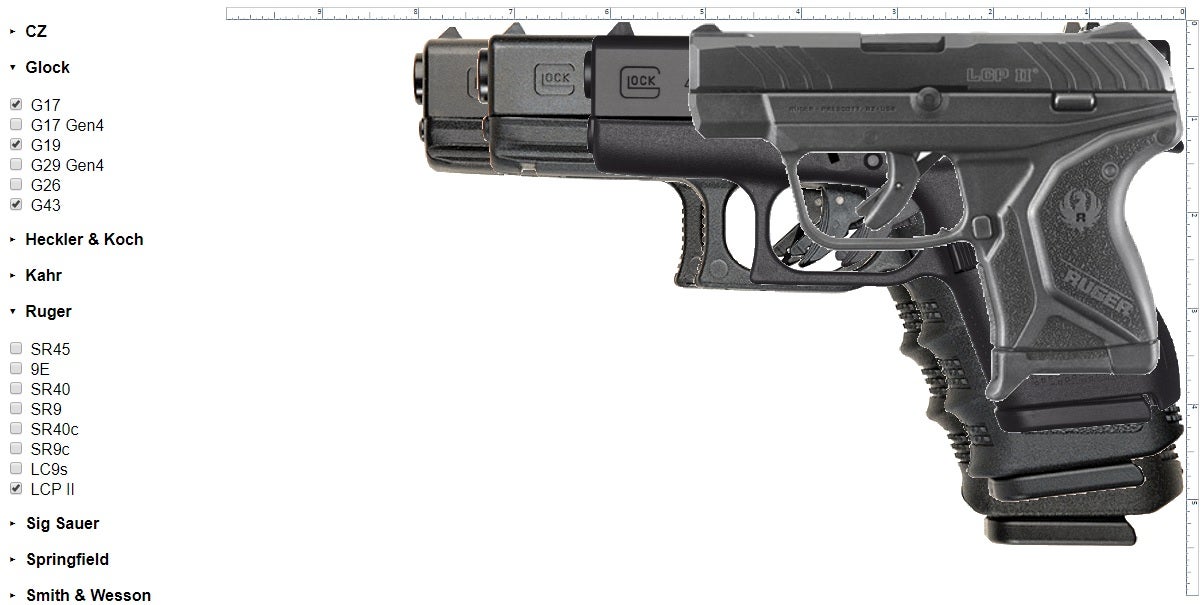
Image from an interactive pistol size chart. Found at https://nivlam.github.io/
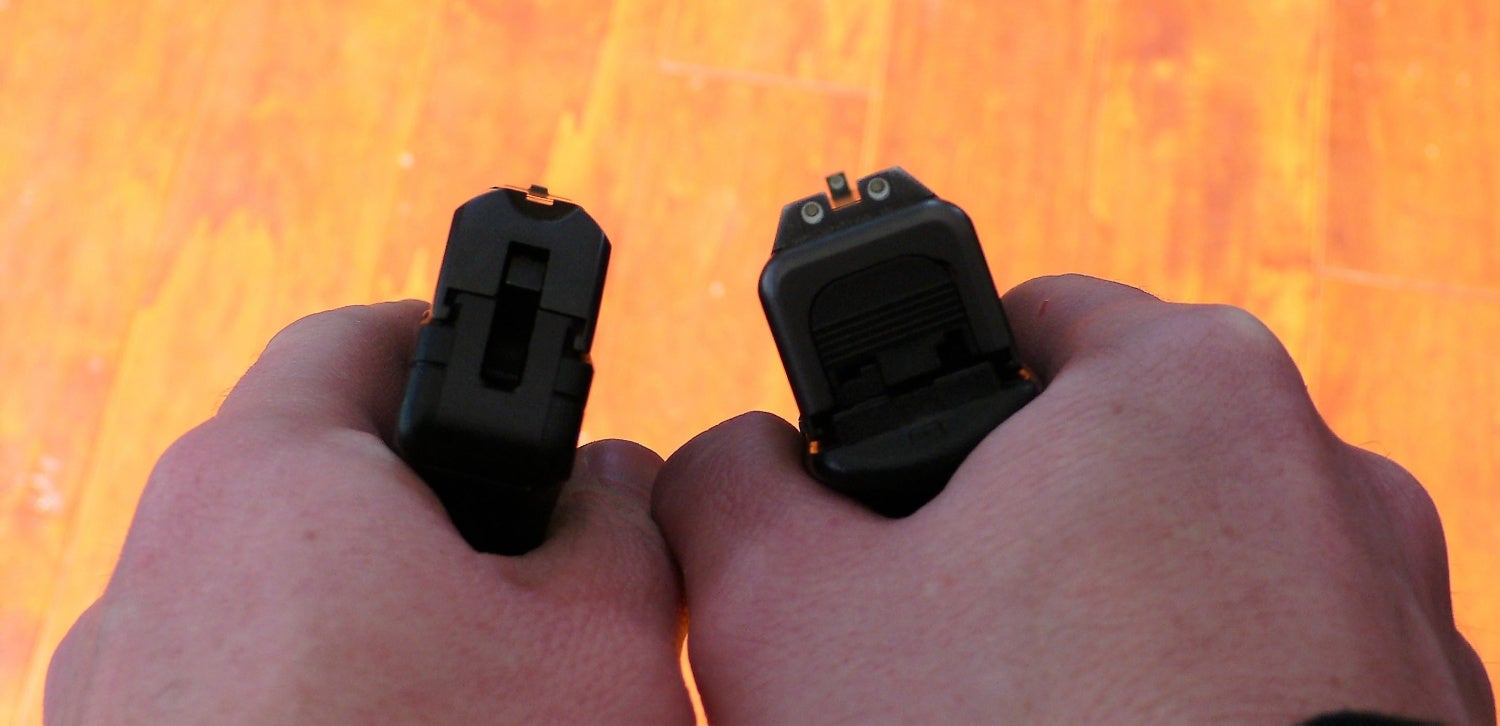
Sight picture of a pocket gun (left) compared to a full sized pistol. Pocket gun sights can be slow to line up.
A WORD ABOUT BALLISTICS, WALLS, AND THE NEIGHBORS
When talking about home defense, we’re talking about the possibility of having to shoot an intruder. It is therefore advisable to use ammunition designed for expansion, that way the bullet hopefully dumps all of its energy into your assailant to stop the fight. But what happens if you miss?
There have been countless tests to see what a bullet will do against doors, drywall and windows. One of the first comprehensive tests I saw was on theboxotruth.com. “Old Painless” documented his experiments to give readers a chance to see what various loads from handguns, rifles and shotguns do when meeting household materials. In the linked test, a 9mm hollow point bullet “went through all four walls like butter.” Naturally, we won’t always have control of where a deadly force encounter takes place or at what angle we’ll have to take the shots to save ourselves and loved ones. We’d prefer not to have to shoot in the same direction as a loved one is sleeping, or in the case of apartments, where the closest neighbor is. Each situation is different though and a shoot/no-shoot assessment will have to be made quickly. Knowing how your chosen home defense load might react if you miss could be helpful in making that decision.
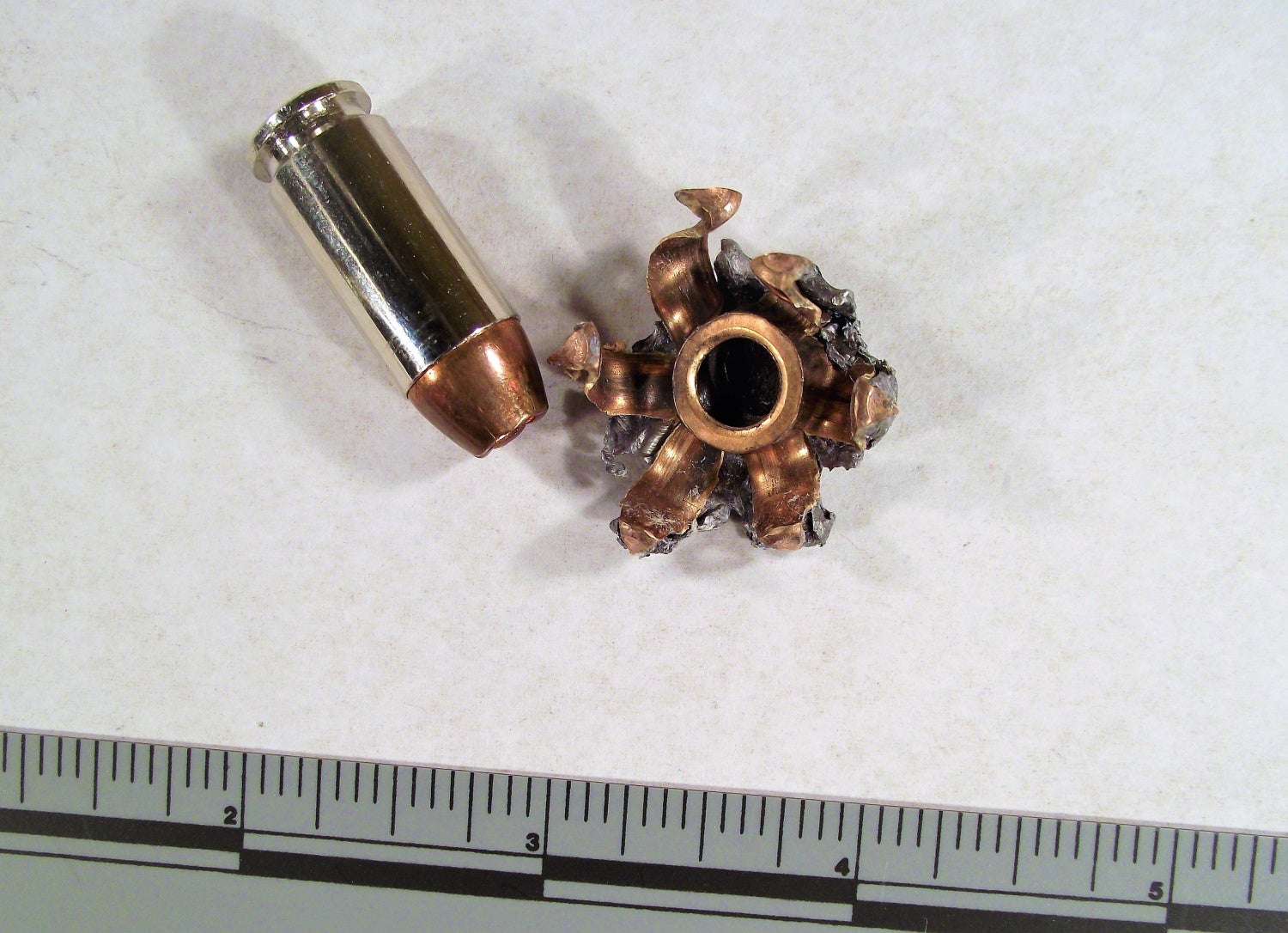
Author’s test of .40S&W Winchester Ranger-T duty ammo into wet newspapers and magazines. Not exactly scientific, though.
TFB TV’s Andrew has done a video series on defensive handgun ammunition using the FBI’s methods of shooting into ballistic gelatin. Check out his videos to see if he’s covered a load you’re interested in or to find something you feel comfortable using. Lucky Gunner also conducted a large test using different calibers, and different ammunition manufacturers and loads within each tested caliber. These tests don’t conclude what will happen in each self-defense scenario, but they provide good information about how consistent (or inconsistent) any given bullet can perform.
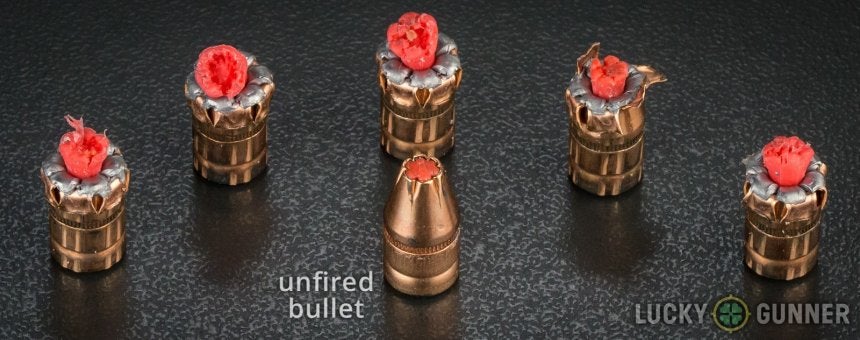
Example of Lucky Gunner’s comprehensive ballistics testing. 9mm Hornady FTX shown.
CALIBER CHOICES, COMMON AVAILABILITY, AND RECOIL
Choosing your first home defense handgun doesn’t necessarily have to start with the gun itself. You may start with the caliber, then choose the gun. Perhaps you’ve heard how great caliber “X” is and you want to start with that. The 9mm cartridge, for example, is offered by almost all manufacturers that produce handguns and your options span not only all sizes of semi-auto pistols but revolvers too. The .357 magnum cartridge is mostly associated with revolvers, however, there are several semi-auto pistols chambered in that caliber as well.
As mentioned in the series intro, choosing a commonly available caliber provides you access to it at local gun stores and other retailers that sell ammo. Internet ammunition sales can make up for local deficiencies, but not all areas have legal access to having ammo shipped right to your door. The most common calibers for self-defense, in general, are also found in home defense handguns.
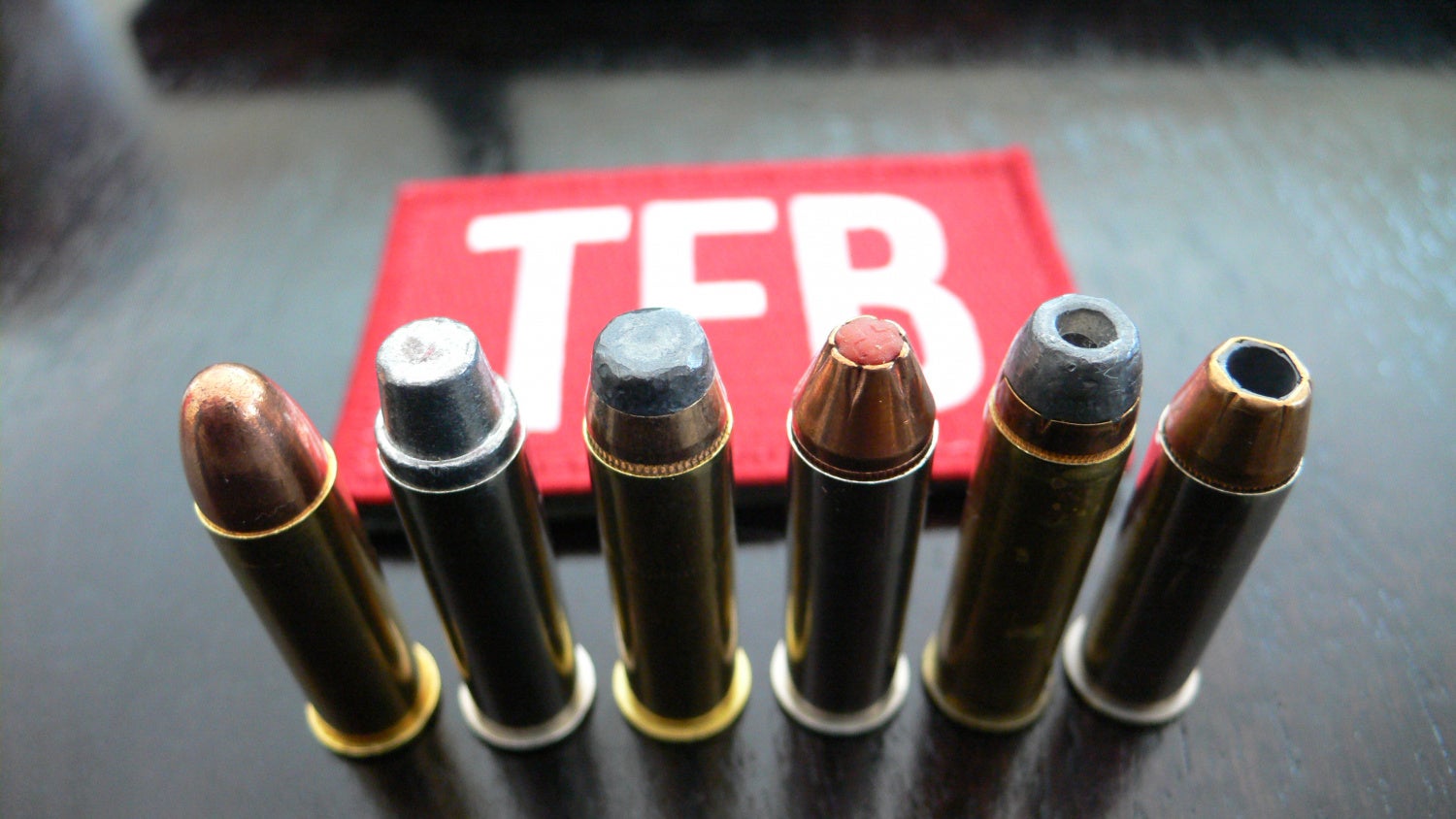
Commonly available bullet types. From left to right; Full Metal Jacket (FMJ), Semi Wadcutter (SWC), Jacketed Soft Point (JSP), Flex Tip (Hornady’s FTX), Semi Jacketed Hollow Point (SJHP), Hollow Point (HP).
WHERE DO I START?
I asked the TFB staff to give their recommendations for a first handgun for home defense, that you’d see specific examples from very experienced shooters. They mostly echoed my theory on full size without me telling them that was one of my main recommendations:
Nick C. “Full size Glock 17 with white light, red dot and 33 rd mag. There is no reason to use a small pistol unless you are compromising for concealment. Oh, and suppressed.”
Matthew M. “I’d say a Glock 19 with a decent surefire white light. Keep it simple.”
Rusty S. “Any full size with tritium sights or RDS and rail for mounting a light/laser combo. Threaded barrel and suppressor are a plus indoors. Example: CZ 75 SP-01 Tactical Urban Grey Suppressor Ready. If four legged intruders are more of a common threat for rural or semi-rural situations, 10mm is a good choice such as with the XDM 5.25” 10mm or Glock G20. A plate carrier with holster and mags is a good accessory as most holsters don’t work with boxer shorts or pajamas.”
Mike R. “First handgun should the one that is most comfortable, the best hand weld. Everything else can be taught.”
Pete “Glock 45 with a Surefire.”
If you are considering purchasing your first handgun for home defense, I hope this has given you some insight and things to chew on when it comes to what type of gun you’d like to start with. Below are some common handguns within several different price points. It’s impossible to list them all, but this is a short list to let you see common handguns that are generally known for their quality and reliability. Prices are subject to change.
$150-300
Ruger EC9, Ruger LCP, Hi-Point 9mm
$300-600
Ruger Security 9, S&W M&P9, S&W M&P M2, Sig P320, Glock 17 Gen 5, Glock 19, Ruger LCR
$600+
HK VP9, CZ SP-01, S&W 686+, Ruger GP100, Glock 45
For our faithful readers, what else would you add to a prospective first-time firearm buyer with home defense in mind? What gun do you keep handy for bumps in the night?
We are committed to finding, researching, and recommending the best products. We earn commissions from purchases you make using the retail links in our product reviews. Learn more about how this works.
 Your Privacy Choices
Your Privacy Choices
